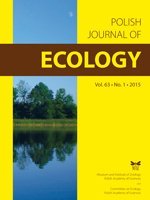Isopyrum thalictroides is classified as an indicator species of the so-called ‘old-growth forests’. It occurs in shady deciduous forests and is a characteristic species of the order Fagetalia silvaticae. In many parts of Europe and Poland, it is classified in Red Lists of endangered species with different threat levels. Studies of an occurrence of I. thalictroides were carried out in the years 2000–2002 and 2010–2012 to examine changes in the abundance and morphological and genetic diversity of populations inhabiting small mid-field forest fragments (populations 2–4) and a compact forest (1 population), all located in east central Poland.
Isopyrum thalictroides cover declined drastically at all isolated sites (from 83 to 93%) whereas the whole species diversity of these phytocenoses increased. By contrast, in the compact forest both, the area occupied by I. thalictroides population and the total community composition only slightly changed over time. When I. thalictroides plants sampled from all studied sites were compared in terms of the biometrical characteristics, populations 3 and 4 were found to be most similar, population 1 was less similar and population 2 was the most different of all populations, probably due to strong anthropogenic pressure.
Electrophoretic analysis of seed and leaf storage proteins of Isopyrum thalictroides obtained from the four sites demonstrated that the populations were quite similar genetically, no matter how distant they were from each another. Population 2 was the most diverse, followed by population 1 whereas populations 3 and 4 were the most similar. A decreasing genetic distance in the I. thalictroides population would lead to inbreeding as seed setting by the plants will be poorer and the seeds will be less viable, which will result in a lower number of plants per a given area.
The decreased gene pool indicates that the population of I. thalictroides is threatened with extinction in this area. Therefore, it is warranted to undertake some conservation measures to protect the species; hence the need arises to monitor it.





